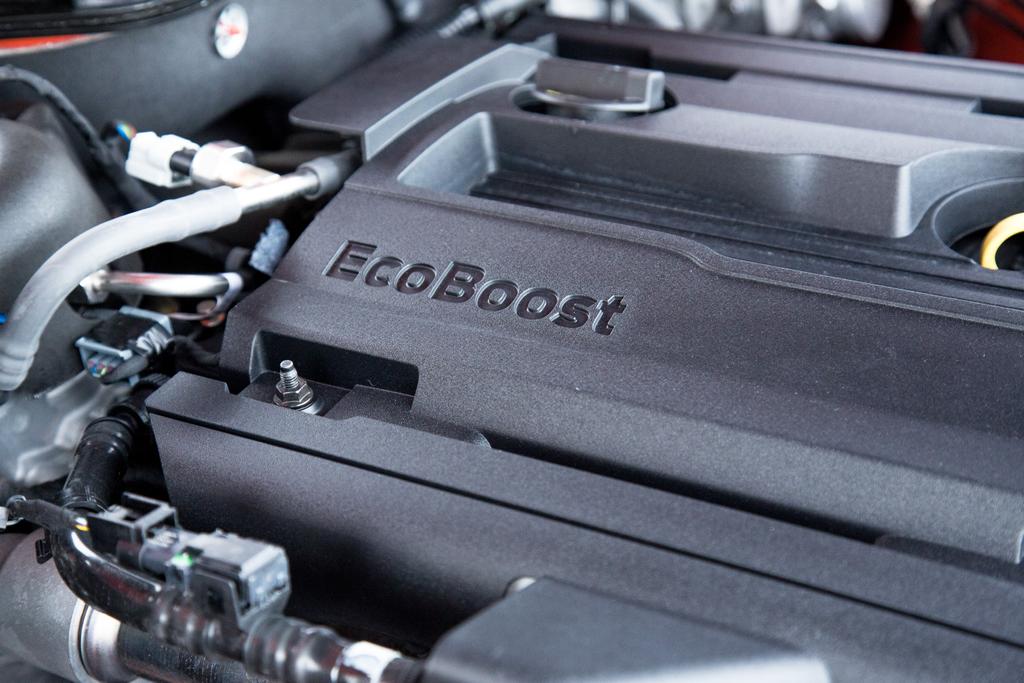
Smaller turbocharged engines are replacing six- and-eight-cylinder engines in just about every automotive segment as a way to improve fuel economy and performance. The 2015 Ford Mustang is no exception and now includes a new 310-horsepower, turbocharged 2.3-liter four-cylinder, which doesn't replace any existing engine in the Mustang lineup, but is an option costing $1,500 more than the standard V-6.
Related: 2015 Ford Mustang expert review
EPA ratings place the EcoBoost at the top of the Mustang's fuel economy range with a 5 mpg increase in combined ratings over the 300-hp, 3.7-liter V-6 and a 7 mpg increase over the 435-hp, 5.0-liter V-8. With the six-speed manual transmission, the EcoBoost is rated at 22/31/26 mpg city/highway/combined, the V-6 is 17/28/21 mpg and the powerful V-8 checks in at 15/25/19 mpg. Compare specifications of all three engines here.
On the road, the 2.3-liter's fuel economy fell right in line with the EPA's ratings in our testing of a 2015 Ford Mustang EcoBoost coupe with the six-speed manual transmission and the Performance Package. During 200 miles of driving we saw observed highway fuel economy occasionally in the mid-30s mpg range at 60-70 mph highway speeds. Add in heavy bumper-to-bumper traffic during a busy Fourth of July weekend for an average of 27.2 mpg and 27.6 mpg on the one-way, 70-mile jaunt from the North Side of Chicago to Michigan City, Ind., and back, respectively. Reflecting the nasty traffic, speeds averaged 30 mph on the way there and 25.68 mph on the way back during an interstate drive that should be mostly highway cruising speeds.
I was fairly kind to the 2.3-liter on those trips; much nicer than while tooling around during the rest of the weekend when the EcoBoost's twin-scroll turbo's quick-spooling whistle proved hard to resist hearing from stoplights. Every one of them, in fact, as I left the car in the most eager Track driving mode, which gets the EcoBoost engine up and going in a hurry to its midrange. That caused mileage to drop from 27.2 mpg to 22.8 mpg after 58 miles of hard driving before being resetting the trip computer for the drive home.
The EcoBoost is the more sport-oriented engine compared with the V-6, generating 10 more hp and 40 more pounds-feet of torque. Ford left out the optional Performance Package on V-6 models, so you'll have to opt for the EcoBoost or the 5.0-liter if you want the most capable handling Mustangs - it's clear which trims are the favorites in the Mustang lineup. The EcoBoost's Performance Package includes a retuned suspension, chassis stiffening, unique electronic stability control and antilock brake programming, wider summer tires, upgraded brakes, black 19-inch wheels and a 3.55 axle ratio.
The advertised peak 310 hp requires premium fuel, which will cut into potential cost savings over the regular-octane-burning V-6. A Ford spokesperson says the EcoBoost makes the same 320 pounds-feet of torque, but fewer horsepower when running regular fuel, and that the engine will adapt to running regular octane like all modern engines.
The EcoBoost should still be less expensive to fill up over the long haul using premium fuel for those who can achieve the EPA ratings, which seems realistic after our fuel economy observations. Theoretically, savings of $173 a year are possible over a V-6 considering the turbo engine's higher fuel economy, and the savings could be $386 a year running regular fuel. That was calculated using $2.81 for regular and $3.18 for premium (the average cost on the day this story was written) and driving 15,000 miles a year.
While it will take more than a few years to offset the additional $1,500 required to get into an EcoBoost model, the exclusivity of the Performance Package and spirited nature of the EcoBoost engine will appeal to Mustang shoppers looking for something more unique than the base V-6 but not quite as costly as the V-8 and its more expensive fuel commitment.
No comments:
Post a Comment